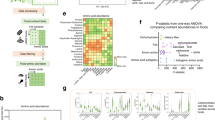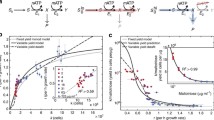Abstract
Natural selection tends to eliminate unutilized capacities because of their costs. Hence we ask how large are the reserve capacities by which biological capacities exceed natural loads, and how closely are related biological capacities matched to each other. Measured capacities (Vmax values) of small intestinal brush-border nutrient transporters are typically around twice their natural loads (dietary intakes of their substrates); the ratio is higher for a transporter of a hyperessential nutrient. Preliminary evidence suggests matching of capacities between different steps in carbohydrate metabolism, and between the intestine, liver, kidneys, and spleen. Symmorphosis — the postulated matching of capacities to each other and to loads — is a testable hypothesis of economic design, useful in detecting and explaining cases of apparently uneconomic design.
Similar content being viewed by others
References
Alexander, R. M., Factors of safety in the structure of animals. Sci. Prog., Oxf.67 (1981) 109–130.
Buddington, R. K., and Diamond, J. M., Ontogenetic development of intestinal nutrient transporters. A. Rev. Physiol.51 (1989) 601–619.
Buddington, R. K., and Diamond, J. M., Ontogenetic development of nutrient transporters in rabbit intestine. Am. J. Physiol.259 (1990) G544-G555.
Buddington, R. K., and Diamond, J. M., Ontogenetic development of nutrient transporters in cat intestine. Am. J. Physiol. (1992) in press.
Diamond, J. M., Evolutionary design of intestinal nutrient absorption: enough but not too much. News in Physiol. Sci.6 (1991) 92–96.
Diamond, J. M., and Karasov, W. H., Effect of dietary carbohydrate on monosaccharide uptake by mouse small intestine in vivo. J. Physiol.349 (1984) 419–440.
Di Magno, E. P., Go, V. L. W., and Summerskill, W. H. J., Relations between pancreatic enzyme outputs and malabsorption in severe pancreatic insufficiency. N. Engl. J. Med.288 (1973) 813–815.
Dudley, R., and Gans, C., A critique of symmorphosis and optimality models in physiology. Physiol. Zool.64 (1991) 627–637.
Dykhuizen, D., Selection for tryptophan auxotrophs ofEscherichia coli in glucose-limited chemostats as a test of the energy conservation hypothesis of evolution. Evolution32 (1978) 125–150.
Ferraris, R. P., and Diamond, J. M., Substrate-dependent regulation of intestinal nutrient transporters. A. Rev. Physiol.51 (1989) 125–141.
Garland, T., and Huey, R. B., Testing symmorphosis: does structure match functional requirements? Evolution41 (1987) 1404–1409.
Hammond, K. A., and Diamond, J., An experimental test for a ceiling on sustained metabolic rate in lactating mice. Physiol. Zool. (1992) in press.
Kacser, H., and Burns, J. A., The molecular basis of dominance. Genetics97 (1981) 639–666.
Karasov, W. H., and Diamond, J. M., A simple method for measuring solute uptake by intestine in vitro. J. comp. Physiol.152 (1983) 105–116.
MacDonald, M. L., Rogers, Q. R., and Morris, J. G., Nutrition of the domestic cat, a mammalian carnivore. A. Rev. Nutr.4 (1984) 521–562.
Obst, B. S., and Diamond, J. M., The ontogenesis of intestinal nutrient transport in the domestic chicken (Gallus gallus) and its relation to growth. Auk (1992) in press.
Rubin, C. T., and Lanyon, L. E., Dynamic strain similarity in vertebrates: an alternative to allometric limb bone scaling. J. theor. Biol.107 (1984) 321–327.
Taylor, C. R., and Weibel, E. R., Design of the mammalian respiratory system. I. Problem and strategy. Respir. Physiol.44 (1981) 1–10.
Toloza, E. M., and Diamond, J. M., Ontogenetic development of nutrient transporters in bullfrog intestine. Am. J. Physiol.258 (1990) G760-G769.
Toloza, E. M., and Diamond, J., Ontogenetic development of nutrient transporters in rat intestine. Am. J. Physiol. (1992) in press.
Toloza, E. M., Lam, M., and Diamond, J., Nutrient extraction by cold-exposed mice: A test of digestive safety margins. Am. J. Physiol.261 (1991) G608-G620.
Author information
Authors and Affiliations
Rights and permissions
About this article
Cite this article
Diamond, J., Hammond, K. The matches, achieved by natural selection, between biological capacities and their natural loads. Experientia 48, 551–557 (1992). https://doi.org/10.1007/BF01920238
Published:
Issue Date:
DOI: https://doi.org/10.1007/BF01920238




